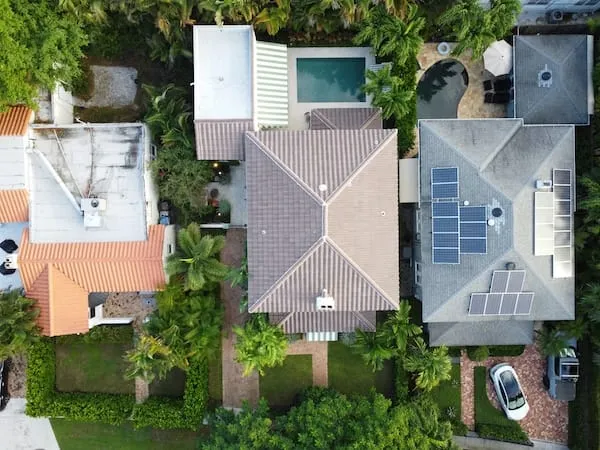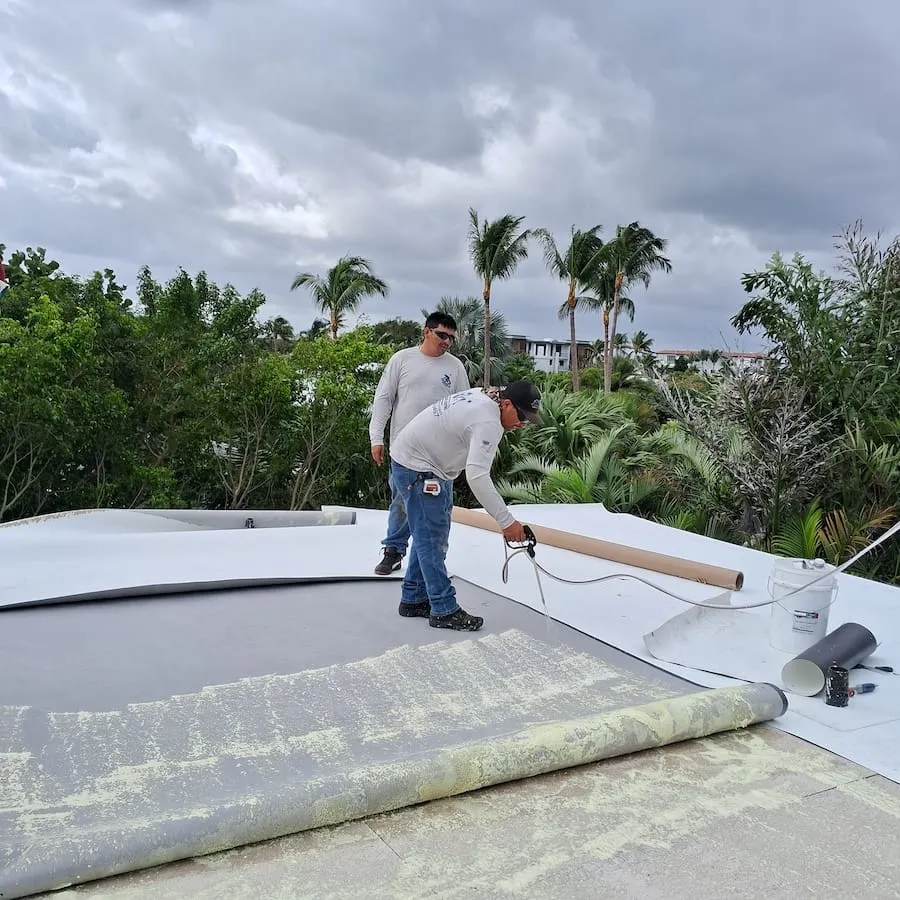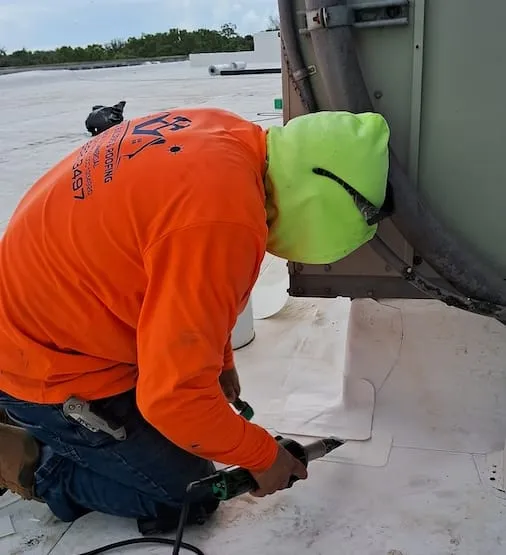Eco Friendly Flat Roof Repair Options
Property owners want more than just a quick patch. They want solutions that protect their investment and the environment. Eco-friendly flat roof repairs deliver both. Using recycled, reflective, and bio-based products, these repairs extend roof life while lowering utility bills and support broader sustainable roofing practices.
In this blog, we’ll cover the most effective eco-friendly options available today, including coatings, recycled rubber roofing membranes, solar integration, and other sustainable products. You’ll also learn the benefits, costs, and maintenance needs of each option so you can make the right decision for your property.
Reflective Coatings for Low Slope Roofs
A reflective coating is one of the most accessible green roofing methods. These coatings bounce sunlight instead of absorbing it, which lowers surface temperature and eases the strain on air conditioning. This is the same principle behind a cool roof, which are designed to stay cooler under direct sun and reduce heat transfer into the building. The result is lower energy bills and a cooler indoor space. These coatings also protect the underlying membrane from UV damage, slowing down the aging process of the roof.

It’s important to note that not all reflective coatings provide waterproofing. Some are designed only to improve energy efficiency and shield against heat, while others also add a water-resistant layer. Knowing the difference before installation ensures you get the performance your roof actually needs.
Common Coating Materials
The most common coatings include silicone, acrylic, and polyurethane. Each material has unique strengths. Silicone handles ponding water better than most alternatives, while acrylics provide excellent reflectivity at a lower cost. Polyurethane adds toughness, making it suitable for a roof that sees foot traffic or equipment. Choosing the right material depends on budget, roof condition, and local climate.
Benefits of UV Resistant Coatings
The main benefits are energy efficiency and extended roof life. Studies from the U.S. Department of Energy show that a reflective roof can lower cooling demand by up to 15 percent in hot climates. By reducing heat transfer, these coatings also help prevent cracking and splitting caused by thermal expansion. For property owners, this means fewer repairs and a longer-lasting roof surface. And if your roof already has damage, it’s important to know whether a sustainable coating will help or if a full repair is needed — our guide explains how to tell the difference.
Recycled Rubber Membranes
Recycled membranes turn old tires and industrial rubber into new roofing products. This process reduces landfill waste and puts recycled materials back to work as a durable, flexible option for flat roofs. They perform well in hot, storm-prone climates because they resist cracking and handle temperature swings better than many traditional products, making them one of the most reliable recycled roofing solutions available today.
Some recycled systems even qualify for LEED credits, making them attractive for eco-conscious businesses. Brands like Euroshield and Firestone offer tested solutions backed by warranties, giving property owners confidence in both performance and longevity.
How Rubber Membranes Are Made
Manufacturers shred recycled tires, treat the rubber to remove impurities, and then press it into sheets that can be applied as roofing membranes. Some systems use crumb rubber mixed with binding agents, while others create seamless rolls. These membranes often include reinforcement layers that strengthen them against punctures and tears.
Performance Compared to Traditional Products
Compared to traditional asphalt-based systems, recycled membranes are more flexible and resistant to cracking. They also handle temperature changes well, which reduces stress on seams. While the upfront cost can be slightly higher, the long-term performance makes them competitive. Property owners often see savings through fewer repairs and longer replacement cycles.
Green Roof Systems
Green roofs, sometimes called living roofs, add soil and vegetation to the top of a building. They absorb rain, provide natural insulation, and create a habitat for plants and wildlife. In cities, green roofs help reduce the “heat island effect,” where dense pavement and buildings trap heat.
Vegetative Roof Repair
This roofing system requires specialized care when leaks or drainage issues develop. Repairs often involve re-sealing the waterproof membrane beneath the soil layer. Since plants sit in planters above the roof surface, those planters are temporarily removed during repairs so the damaged area can be accessed and sealed properly.
Design and Maintenance
Drainage is one of the most important maintenance points. Even with low-shedding plant species, debris can build up and block drains. Routine inspections keep water moving off the roof and prevent root damage or pooling. When maintained correctly, this roofing system continues to protect the structure while delivering energy savings and environmental benefits.
The design of a green roof directly impacts its performance. Most systems use hardy, low-maintenance vegetation such as sedum that thrives in shallow soil with minimal upkeep. Maintenance focuses on irrigation checks, soil health, and monitoring drainage performance. With consistent care, the vegetation shields the waterproofing membrane and helps the roof last for decades.

Solar Panel Integration
Solar panels work well on flat roof materials because they generate clean energy while also helping protect the roof. The panels block harsh UV rays from hitting the surface and even add extra shade, which can lower cooling costs inside the building.
Low slope roofs are ideal for solar installations because they provide wide, unobstructed areas for panels. Ballasted racking systems are often used, which hold panels in place without penetrating the membrane. This minimizes leak risk while ensuring panels can withstand high winds.
Average Lifespan of Solar Roofing
Most panels last 25 to 30 years. Their lifespan often exceeds that of the roof they are installed on, so pairing panels with a durable membrane is critical. When repair is needed, panels can be temporarily removed and reinstalled.
Choosing the right mounting system during installation is critical. Ballasted racks avoid roof penetrations but add weight, while attached systems require waterproof flashing at every fastener. If the wrong method is used, leaks or structural strain can occur, leading to expensive repairs. When water intrusion or structural stress is left unchecked, even solar systems can be compromised. Our guide on delayed roof repair explains the risks and costs of waiting too long.
Sustainable Roofing Products
Eco-friendly roofing is about more than coatings and plants. The industry now offers sustainable products that use recycled, renewable, and less toxic materials.
Recycled Roofing Products for a Low Slope Roof
These include membranes made with recycled plastics or rubber, as well as insulation boards manufactured from repurposed wood fiber. They perform comparably to standard products but reduce the demand for virgin raw materials.
Bio-Based Roofing Membranes Explained
Bio-based roofing membranes use plant-derived oils and resins instead of petroleum. These sustainable materials provide waterproofing and flexibility while lowering carbon footprint. While still a newer category, they are gaining attention as technology improves durability and cost efficiency.
Rainwater Harvesting Systems
Flat roofs make excellent rain harvesters because they provide wide, even surfaces that collect water efficiently. Instead of letting that runoff head straight to the storm drain, you can capture it, filter it, and store it for reuse. Many property owners put it to work in irrigation, cooling equipment, or other non-drinking purposes that still save money and resources.
Designs for Rainwater Collection
A simple setup might be as straightforward as gutters and downspouts feeding into a storage tank. Bigger or more advanced systems often include filters to remove debris, pumps for water pressure, and even underground tanks for long-term storage. The right design comes down to how much water you expect to collect and what you want to use it for.
Benefits of Reuse Systems
For commercial buildings, harvested water from the rain can supply irrigation for landscaping or serve as make-up water for cooling towers. On homes, it can handle lawn watering, garden beds, or outdoor cleaning jobs. In both cases, reusing roof runoff reduces pressure on city water systems, lowers monthly utility costs, and puts your roof to work in a way that benefits the property and the environment.

Adhesive Options for Eco Repairs
Today, property owners have several environment friendly adhesive choices. Water-based products reduce harmful fumes without sacrificing strength. Low-solvent adhesives cut emissions while still performing well in Florida’s tough climate. In some cases, roofers can use self-adhered membranes that require little or no adhesive at all, eliminating the concern almost entirely. These options give you the same secure bond while making your roof repair safer and more sustainable.
Low VOC Adhesives
Adhesives play a big role in flat roof refurbishment, but many of the older products released high levels of volatile organic compounds (VOCs). These chemicals impact air quality, cause respiratory irritation, and contribute to smog. Low VOC adhesives solve that problem by cutting down emissions, which makes the job site safer for workers and the finished building healthier for occupants.
Why Low VOC Matters
Switching to low VOC products isn’t just about comfort, it’s about compliance and long-term health. Green building standards like LEED often require low VOC materials, and even local codes may limit VOC levels. Using the right adhesive keeps your project within guidelines while protecting both the environment and the people who live or work under the roof.
Reflective and Eco-Friendly Membranes
Modern flat roof membranes are not all the same. Some are built for strength, others for flexibility, and some focus on energy savings. Choosing the right one means weighing cost, durability, and performance in Florida’s climate. Reflective and eco-friendly membranes stand out as sustainable flat roof options because they can lower utility bills while still offering long-term protection.
Thermoset EPDM Membrane
EPDM is a synthetic rubber membrane that has been used for decades. It is known for flexibility and reliability, especially in climates with strong UV exposure. Black EPDM absorbs heat, which can drive up cooling costs, but white EPDM offers reflective benefits that keep surface temperatures lower. The material works well on both residential and commercial flat roofs and is valued for its long service life when properly maintained.
Thermoplastic Polyolefin (TPO)
TPO has quickly become one of the most common flat roof system in South Florida. It balances affordability with performance and is heat-welded at the seams for a watertight finish. Because it is usually manufactured in white or light colors, TPO reflects heat and supports lower cooling bills. When paired with skilled installation, it provides strong resistance to punctures and UV damage, making it a practical option for both homes and large buildings.
Spray Polyurethane Foam (SPF)
SPF is unique because it is sprayed directly onto the roof surface. The foam expands, creating a seamless, insulated barrier that reduces energy use while protecting against leaks. It adheres tightly to the roof deck and fills in small gaps or irregularities, which makes it especially effective on an aging or uneven roof. With routine maintenance such as re-coating every 10 to 15 years, SPF roofs can last for decades.

FAQ on Eco-Friendly Flat Roof Repairs
Are Recycled Rubber Membranes More Expensive Than Traditional Materials?
They can cost a bit more upfront depending on the brand and spec, but the value comes from reduced waste, potential sustainability credits, and meeting ESG or LEED goals. In day-to-day use, performance and maintenance are similar to conventional single-ply options when the product is installed correctly. Any long-term savings usually come from program incentives, waste diversion, and pairing the membrane with energy-saving upgrades like coatings or better insulation, not because the membrane itself is inherently more crack or weather resistant.
What Is the Average Lifespan of a Solar Panel Integrated Into a Low Slope Roof?
Typically, 25 to 30 years. When they are paired with a durable flat roof membrane, like metal, the roofing system holds up for the full lifespan of the panels. Preventing premature roof replacement from cutting the solar system’s value short.
Are There Any Specific Maintenance Requirements for a Vegetative Roof?
Yes. These require irrigation checks, clear drainage paths, and routine upkeep of the plant layer. Because plants and soil add weight, ignoring maintenance can lead to clogged drains, pooling water, or stress on the roof deck. Regular care keeps the system healthy and functional.
How Much Do Eco-Friendly Repairs Cost?
Costs depend on the material and scale of the project. Coatings may cost only a few dollars per square foot, while larger upgrades like solar integration or green roof systems require higher upfront investment. Over time, however, these solutions usually offset their costs through lower energy bills and fewer repairs.
Can Green Roofing System Be Installed on Any Type of Building?
Not every building is suited for a green roofing system. Soil and vegetation add considerable weight, so the structure must be strong enough to carry the load. A professional inspection is always needed before moving forward. Unlike a flat roof, a vegetative system isn’t necessarily practical for a sloped roof, property owners can still choose renewable approaches like solar tiles or recycled shingle. Both options are environmentally friendly and well-suited for sloped roof buildings.
Hire Certified Experts You Can Trust
Florida property owners deserve a team that stands behind its work. As a GAF and Mule-Hide certified roofing company, we deliver the highest level of craftsmanship with warranties that last up to 30 years on labor and materials. Our experience spans more than two decades, covering everything from small roof repairs to complete flat roof replacements. Every project is built to handle Florida’s harsh weather and backed by the reputation of one of the most trusted teams in the state. When you want your roof fixed right the first time, call the professionals who guarantee it. Contact us today for a free quote.
